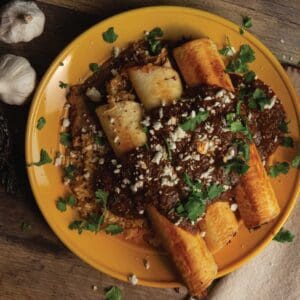
Pheasant Flautas
This Mexican inspired recipe is sure to be a family favorite while using up your pheasant meat
Ingredients
- 1 pound deboned pheasant
- kosher salt and freshly cracked black pepper
- 2 tbsp Sambal chili paste
- 1 ½ oz tequila
- 48 oz chicken stock *If not using a sous vide
- 1 medium yellow onion finely diced and caramelized
- 12 medium flour tortillas
- 8 oz Mexican shredded cheese (any mix of asadero, oxaca, or quesadilla)
- 2-4 oz cotija cheese (you could use feta in a pinch)
- Freshly chopped cilantro
- Avocado oil or similar cooking oil
- Cornstarch to make a slurry to serve as glue for tortillas
Green Chili Enchilada Sauce Ingredients
- 1 ½ pounds tomatillos roasted and pureed
- 5 large jalapeños halved, seeded, roasted, and pureed
- 4 large garlic cloves roasted and pureed
- ½ cup pepper purée (or tomato paste or pureed chipotles in adobe sauce)
- 2 tbsp creamy peanut butter
- 2 tbsp honey
- 1 tbsp chili powder
- 1 tbsp dry oregano
- 1 ½ tbsp kosher salt
- ½ tbsp cumin
- ½ tbsp apple cider vinegar
Instructions
- Make the sauce first. Remove the husks from your tomatillos. Cut off the stems, halve, and remove the seeds from your jalapeños. Peel the garlic. Lightly oil all these vegetables and roast them at 250 degrees Fahrenheit for one hour.
- Meanwhile, remove the seeds from the dry chiles and rehydrate them in hot water for 10 to 15 minutes, or until soft. Remove the stems and blend them thoroughly in a blender. A food processor won’t blend the chiles as thoroughly.
- Once the tomatillos, garlic, and jalapeños are adequately roasted, thoroughly blend all of them along with 1/2 cup of your pepper purée. Add the mixture to a medium saucepan along with the peanut butter, honey, chili powder, dry oregano, kosher salt, cumin, and apple cider vinegar. Barely simmer the sauce for one hour, stirring frequently and being careful not to let it burn. Salt to taste.
- To prepare the pheasant, debone all the meat and lightly dust it with kosher salt and freshly cracked black pepper. If you’re using a sous vide, seal the pheasant meat up with tequila and chili paste. Sous vide cook at 180 F for two hours for breast meat or eight hours for leg and thigh meat. This may require you to separate different cuts into different sous vide bags. If you’re not using a sous vide, after seasoning the meat, add it to a medium saucepan and cover it with chicken stock plus chili paste and tequila. Barely simmer the meat for 2.5 to three hours, or until all meat shreds easily.
- When you’re ready to prep and cook the flautas, in a large skillet, add a thin layer of avocado oil (or similar cooking oil). Heat it on medium-high. Add the finely minced yellow onion and lightly salt and pepper it. Once it’s slightly seared, turn the heat to medium-low. Remove the onions once they’re slightly caramelized and soft, approximately 20 minutes.
- Add a bit more avocado oilI to that same skillet that you cooked the onion in. Turn the heat medium; the ideal frying temp here is 400 F.
- Shred your pheasant meat and mix it with Mexican-style shredded cheese. Add it to the middle of each tortilla and roll it up tightly. Remember, it should look like a flute. To seal the edge of the rolled tortilla end, mix a bit of cornstrach with water to create a paste. Add that paste to the edge, which serves as an adhesive.
- Roll all flautas and fry two to three at a time, being careful to not crowd the skillet. Rotate them until the sides are golden brown. Remove them and let grease drip off. You may wish to have them sit on a paper towel for half a minute and turn to remove the extra grease. Plate them, top them with sauce, then cotija cheese crumbles. Garnish with freshly chopped cilantro. Enjoy!
Notes
Note: Pepper purée is made from rehydrated dried 4-5 each of California and chipotle chiles (seeded, stems removed before blending thoroughly).
Reach out to me on Instagram (@WildGameJack) with any questions or comments.
Tried this recipe?Let us know how it was!